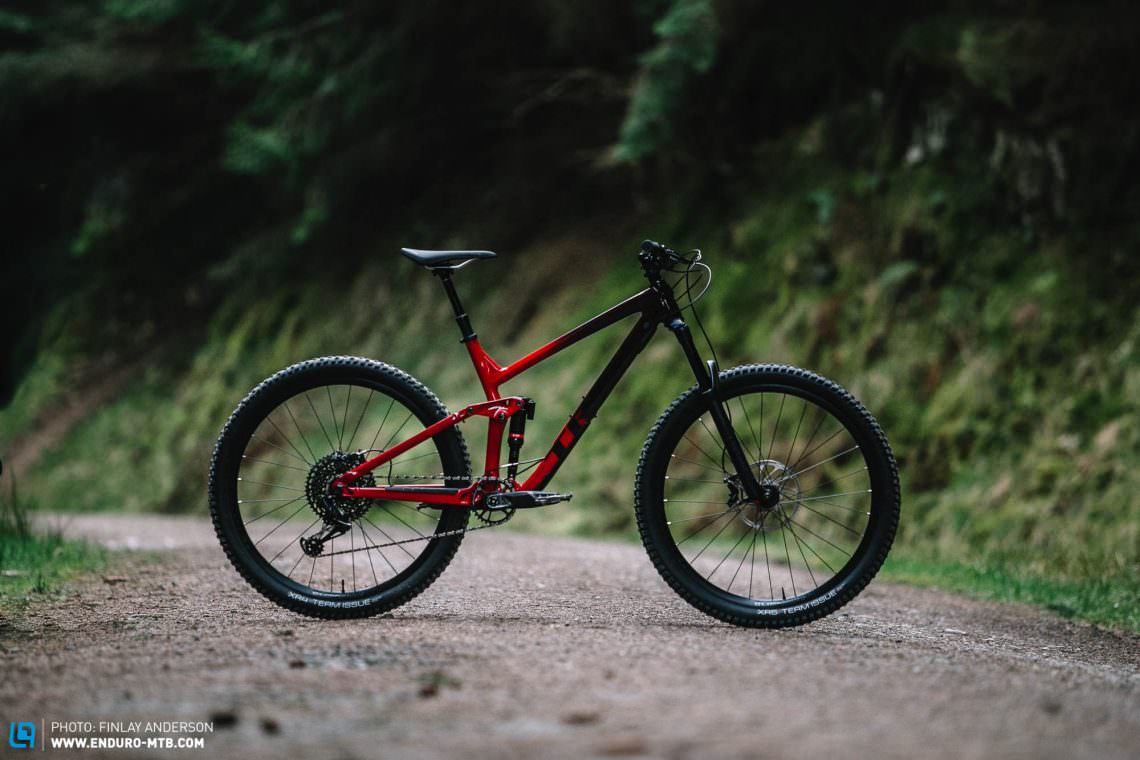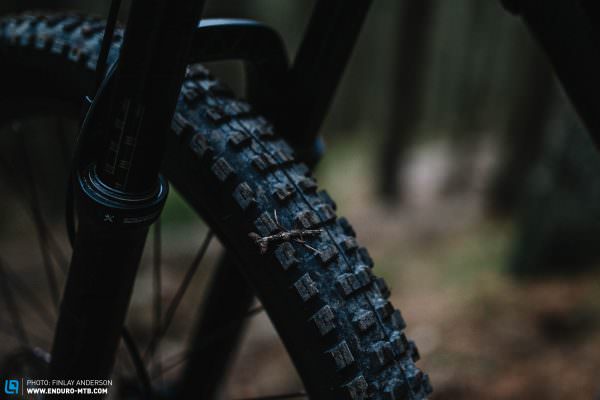The Trek Slash 8 took top honours in last year’s affordable enduro bike group test. Rather than retire quietly, the Slash 8 has dusted off it’s championship belt and is back in the ring again. But, one year on, can the middle-weight still go 12 rounds with the big-hitters?
For an overview of the test fleet head to the group test: What’s the best 2020 Enduro Bike under € 3,500 – 9 mountain bikes in review

The Trek Slash 8 in detail
In 1981, Bill Gates supposedly once made the statement “640K ought to be enough for anybody.” Today, the latest iPhone 11 has nearly 10,000 times that capacity in its RAM. The same goes for bikes. When Trek launched the Slash back in 2016, with an (at the time) massive 160 / 150 mm of travel (for a 29er), we were blown away. It was a monster. Times have changed and in this test the Trek Slash 8 looks a little undergunned. However, there is life in the old dog yet and the Trek isn’t quite ready for retirement. After winning our test last year, we thought we would bring the Trek back for another round to see if it can hold onto its title. The carbon Slash was arguably the bike that started the long travel 29er movement, but it was the affordable aluminium version that attracted the masses with more aggressive geometry (8 mm longer reach and 0.8° steeper seat tube angle) and attractive € 2,999 price point. The Slash 8 features a 160 mm RockShox Yari RC fork and RockShox Deluxe RT3 RE:aktiv shock with Trek’s proprietary Thru Shaft technology. A SRAM GX Eagle drivetrain does the shifting, while SRAM Guide R brakes with 200/180 mm rotors reign in the fun (in more ways than one). The rest of the cockpit comes from Trek’s own Bontrager brand, as are the 150 mm dropper post and XR4 tires.

You cannot feel the Knock Block on the trail, which protects the Straight Shot down tube from spinning forks. It’s only a pain if you need to put your bike in the car.

The SRAM Guide R brakes look and feel out of place on this bike, lacking the power needed to match the performance of the bike.

The suspension leverage curve of the Trek Slash 8 is perfectly balanced to the bike. Not so progressive that it feels harsh at low speeds, but ramping up enough to help pop you into the air.
Trek Slash 8 29
€ 2,999
Specifications
Fork RockShox Yari R 160 mm
Rear Shock RockShox Deluxe RT3 RE:aktiv Thru Shaft 150 mm
Seatpost Bontrager Line 150 mm
Brakes SRAM Guide R 200/180 mm
Drivetrain SRAM GX Eagle 1x12
Stem Bontrager Line Knock Block 50 mm
Handlebar Bontrager XR Elite 780 mm
Wheelset Bontrager Line Comp 29"
Tires Bontrager XR4 Team Issue 2.4"/2.4"
Technical Data
Size S M ML L XL
Weight 14.4 kg
Specific Features

Trek’s proprietary Thru Shaft shock allows the piston shaft to travel through the shock. As such, the damping oil doesn’t get displaced by the shaft, removing the need for an internal floating piston.

The Bontrager XR4 tires lack aggressive side knobs to bite in the corners and on loose trails – they roll fast though

The Trek Slash’s cable management is exemplary, staying totally silent as you hammer down the hill. The only noise you will hear is your howls of joy.
The geometry of the Trek Slash 8
The Trek comes with the geometry adjusting Mino Link, allowing you to swap between a steep and slack setting. As with most flip chips, we put the bike in the slack setting and left it there. Compared to the rest of the bikes in this test field, the Trek is the most conservative, with a short 453 mm reach in size Large, 1219 mm wheelbase and short 434 mm chainstays. The 65.1° head angle and slack 74.4° seat angle will disappoint those looking for radical geometry. The geometry is finished with a 621 mm stack and 28 mm bottom bracket drop.
| Size | S | M | ML | L | XL |
|---|---|---|---|---|---|
| Seat tube | 394 mm | 419 mm | 445 mm | 470 mm | 521 mm | Top tube | 582 mm | 597 mm | 613 mm | 627 mm | 653 mm |
| Head tube | 100 mm | 100 mm | 105 mm | 110 mm | 125 mm |
| Head angle | 65.1° | 65.1° | 65.1° | 65.1° | 65.1° |
| Seat angle | 65.6° | 65.6° | 65.6° | 65.6° | 65.6° |
| Chainstays | 435 mm | 435 mm | 435 mm | 435 mm | 435 mm |
| BB Drop | 28 mm | 28 mm | 28 mm | 28 mm | 28 mm |
| Wheelbase | 1,172 mm | 1,187 mm | 1,204 mm | 1,219 mm | 1,248 mm |
| Reach | 410 mm | 425 mm | 440 mm | 453 mm | 475 mm |
| Stack | 612 mm | 612 mm | 617 mm | 622 mm | 635 mm |
Nimble, direct and balanced, we loved the way the Trek can skip from line to line as if it weighs 2kg less.

Refined and playful, the Trek Slash 8 on the trail
You can feel the heritage of the Trek Slash 8 as soon as you throw a leg over it. The position is familiar and easy going and while the short front triangle appears compact, the slacker seat tube angle ensures that you have plenty of room. Running the saddle fully forwards on the rails to steepen the seat tube for the climbs does bring you quite close to the bars for a head up and tall riding position. At 14.4kg, it’s the lightest bike in the test, and with the fast rolling Bontrager XR4 tires, it feels significantly more sprightly uphill than its competitors. Here it handles more like a long legged trail bike than an enduro bike. The Trek finds lots of traction if you take on the challenge of a technical uphill section and the compact dimensions help keep the front wheel tracking accurately. Anti-squat is moderate, so we found we were reaching for the climb switch of the RockShox Deluxe RT3 RE:aktiv shock to control pedal bob on long fire-road climbs in the bigger gears. Nonetheless, overall the Trek was the most pedal friendly of all the bikes on test.

Downhill, the Trek is a masterclass in poise and balance. It feels noticeably more nimble than the other bikes in this test, hitting lines accurately and skipping into the air with the gentlest pull on the bars. The moderately progressive suspension with its unique ABP design remains very active, even under hard braking, giving you more confidence to charge into sections knowing that you can scrub speed without losing your suspension. It’s best not to get too carried away though as the weedy SRAM Guide R brakes are a trail bike brake at best. The Trek Slash is best ridden differently from the other bikes in this test, connecting gaps and pumping between the best lines, rather than ploughing straight through. When the going gets really tough, the suspension starts running out of travel and just like the Merida ONE-SIXTY the Yari RC starts to struggle, packing down into its travel. The Bontrager XR4 tires offer good grip but lack an aggressive shoulder tread for wet conditions. Overall, one year on, we are still really impressed with the Trek Slash 8. It could be the perfect ‘bridge’ bike for the rider who thinks that they would be best on a trail bike but love the occasional DH track, grassroots enduro race or week in the Alps.



How does the Trek Slash 8 Compare to the other bikes in this test?
The Trek Slash’s nearest rival is the Propain Tyee CF. Both bikes share a nimbleness not shown by any other bike in this test, skipping into the air at every opportunity. The Trek is the more agile bike, pumping for speed and popping shapes, but the Propain Tyee is a more efficient climber and the better fork and longer travel allow the Propain to pull ahead when the trails get really rowdy.

Tuning tips: you may need to change the Bontrager XR4 tires if you ride in the wet | add tokens to the Yari to improve support | upgrade brakes to SRAM CODEs or Guide REs


Conclusion
Returning as the reigning champion, the Trek Slash 8 proved it’s not ready for retirement just yet. If you’re looking for a versatile enduro bike that can still masquerade as a nimble trail bike, the Trek Slash 8 would be our pick of the bunch. Its balanced handling and nimble nature is easy to enjoy whatever your skill level. Only on the roughest trails does it start to lose its cool.
Tops
- loves to play with the trail
- ABP suspension works flawlessly under hard braking
- versatile and nimble
Flops
- disappointing brakes
- Yari fork gets overwhelmed in rough terrain
For more info head to: trekbikes.com
The test field
For an overview of the test fleet head to the group test: What’s the best 2020 Enduro Bike under € 3,500 – 9 mountain bikes in review
All bikes in test: Canyon Torque AL 6.0 (Click for review)| GIANT Reign SX 29 (Click for review) | Ibis Ripmo AF Coil (Click for review) | MERIDA ONE-SIXTY 700 (Click for review) | Nukeproof Mega 290 Expert (Click for review) | Privateer 161 (Click for review) | Propain Tyee CF (Click for review) | Trek Slash 8 29 | YT Capra Comp 29 (Click for review)
Did you enjoy this article? If so, we would be stoked if you decide to support us with a monthly contribution. By becoming a supporter of ENDURO, you will help secure a sustainable future for high-quality mountain bike journalism. Click here to learn more.
Words: Photos: Trev Worsey, Finlay Anderson









